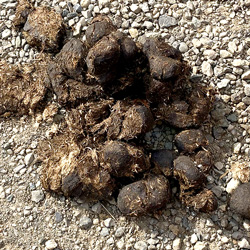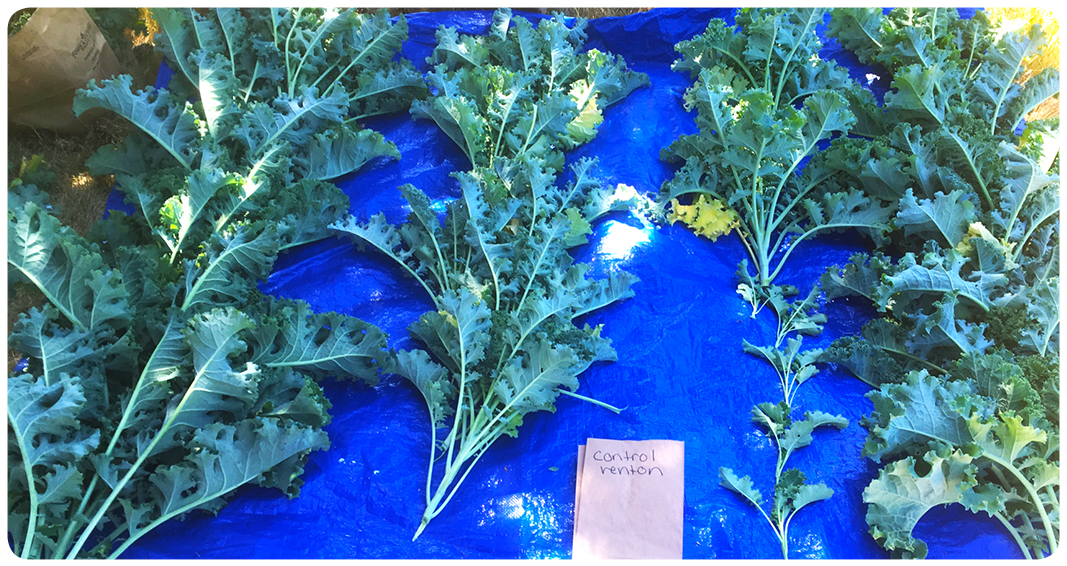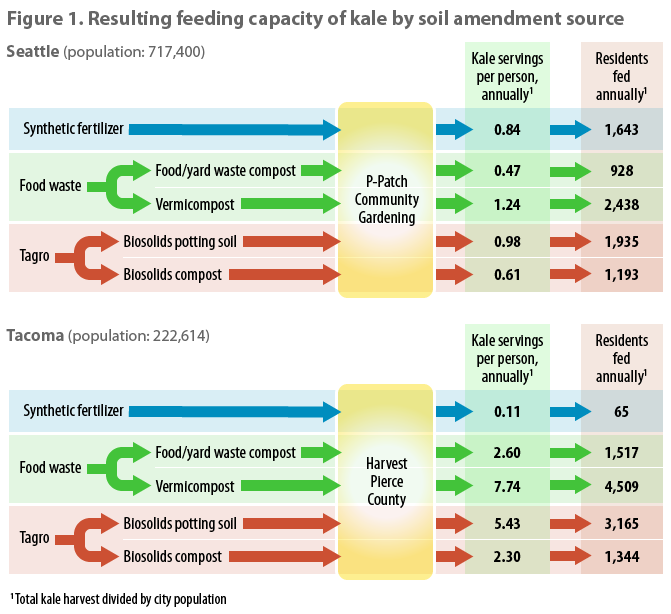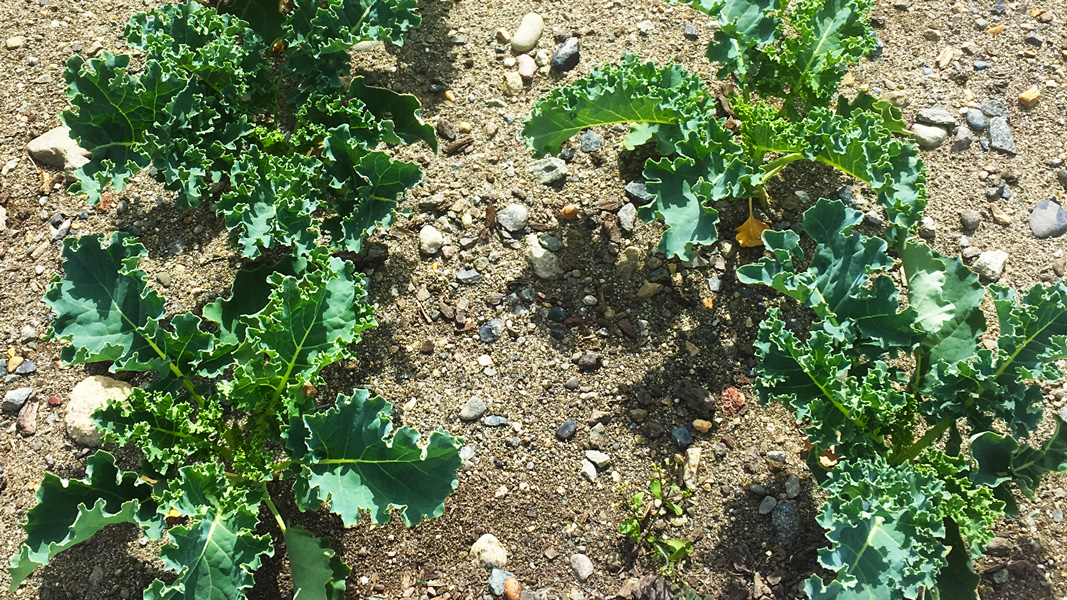Top: Synthetic fertilizer and different urban residuals were tested in community garden plots to measure and compare kale yield.
 Sally Brown
Sally Brown
A tree may grow in Brooklyn but what about a head of cabbage? From personal experience I can attest that Swiss chard, apricots, currants, and peaches can grow in Brooklyn. My grandmother, an immigrant from Germany, took her garden seriously. In fact, I remember stories from my mother that her mom would drag her out at night to go collect the ‘horse apples’ or horse poop for use in the garden. That was during the depression, before the streets had fully transitioned from horses to horsepower. It was just before WWII, or the era of Victory Gardens when almost a third of the vegetables in the U.S. were grown in cities.

“Horse apples”
In the intervening decades, there was a long stretch when vegetables mostly grew in the frozen section of the supermarket. Thankfully, we’ve begun to rediscover fresh food and the benefits of food that is locally grown. There are new words now to describe this. Peri-urban agriculture, food sheds, and locavore are just a few examples. We have CSAs or Community Supported Agriculture and farmers markets. We have a new branch of the U.S. Department of Agriculture for Urban and Innovative Agriculture. All of this is lovely, but is it a trend or something that can have a real impact on our food supply?
This is the third part of the series on how circular cities can be. I covered the basics in Part I, did a nutrient flow analysis in Part II and here I hope to hit the ground planting if not running. Food can be grown in cities in multiple ways — as a source of income, to supplement income or to eat. A number of innovative commercial producers are growing food in nutrient solutions and greenhouses in cities. Gotham Greens is one example that I happen to know. My interest lies in growing food in soil in backyard and community gardens. That is where the most people can be impacted. It is also likely where the most food can be grown. Granted, converting empty office space into growing facilities using nutrient solutions could upend my projection but for this column, let’s figure that the cubicles are turned into condos instead.
Urban Food Production Potential
A number of studies have looked at the potential for food production in urban areas. Aragon et al. (2019) studied maps to find out how much open area was available in Phoenix, Arizona to grow food. The authors estimated yields based on results from other studies and concluded that the city could grow 90% of the produce that is needed to feed its population. One good thing about Phoenix is you can grow outside in the ‘winter’ and then leave the produce outside to ‘cook’ in the summer. Another study done in Sydney, Australia measured yields in community gardens that were higher than those on commercial farms (McDougal et al., 2019). Even though the growers were highly productive the inputs, including time and fertilizer, effectively reduced the efficiency. None of these included yields based on using amendments made from urban residuals.
Other studies have estimated whether there are enough nutrients in cities to grow food for the people who live there. One considering ‘new sanitation’ (aka peeing in buckets) found that there was plenty of phosphorus (P) and a sizeable amount of nitrogen (N) to grow food in Rotterdam, Netherlands (Wielemaker et al., 2016). Another calculated nutrient flows in the Okanagan region of British Columbia (Harder et al., 2021). The urban centers were hot spots for excess N and P. None of these studies considered yield potential for soils amended with composts or soil blends from residuals.
In our study (Brown et al. 2023) we put two and two together and got plenty of kale. Our estimate on how much food can be grown focused on community gardens. Both Seattle and Tacoma, Washington have well established and well used community garden programs. The program in Tacoma provides Tagro potting soil to all gardens, free of charge. The program in Seattle, well, it allows for use of food/yard waste compost.
For this and in a previous study we measured how much growing area each program had and how well used the plots are (Niedzwiecki et al., 2022). In a few other studies we measured relative yield for vegetables and flowers grown with fertilizer or with food scrap-based and biosolids-based soil amendments (Batjiaka and Brown, 2020, Una et al., 2022). By putting these together, with the focus on kale, we estimated how many people each garden program could feed. Now, kale is very trendy. Kale is very nutritious. In my mind, kale should be relegated to hearty winter soups but many think differently. It also grows really easily, doesn’t bolt and is frost tolerant. And you can cut leaves from a plant for much of the year. Here we based our estimates on a single harvest.
 How Much Kale Can We Grow?
How Much Kale Can We Grow?
Seattle has a lot more people than Tacoma — just under 800,000 compared to just over 200,000. The Seattle P Patch program provides 6.25 ha (15.6 acres) of growing space across 89 community gardens. The Harvest Pierce County program in Tacoma had 85 gardens (now over 90) and a farm when we surveyed the plots. A total of 4.3 ha (10.75 acres) is devoted to growing. For amendments, our estimates were based on how plants grew with biosolids compost (made from the King County biosolids), the Tagro biosolids potting soil from Tacoma, a food/yard waste compost from Seattle and vermicompost made from food scraps at the program at the prison in Monroe, Washington. We added a lot of compost to the soils — about 200 tons/ha (2.5 acres). Many urban growers grow exclusively in compost and many grow in raised beds filled with Tagro potting soil.
How much kale you get depends. We grew vegetables on both high and low quality soils. With a poor quality soil, as so many urban soils are, without organics you are back to the frozen food aisle. Add organics and it’s kale Caesar for supper. With a good quality soil and the right amendment, you can match or top the yields from synthetic fertilizer. With the right amendment, kale grown on poor soil had higher yields than kale grown with fertilizer on rich soil. Our estimates taught us two lessons.
First, the amount of food that can be grown in community garden plots is pretty significant. Extrapolate to back yards and you could be feeding the city. Seattle’s community gardens have good soil conditions and Tacoma’s have poor soil conditions. Figure 1 shows how many people you could feed one portion of kale per day for a year.
If you take into account that about half of Seattle’s population and two-thirds of Tacoma’s live in single family homes (likely with back yards), that is more kale than even a true aficionado could eat every year. Making the connection between the nutrients we waste and the food that we eat could close a loop. Doing so has a range of benefits for the people who participate and for the place that they live. Growing a portion of what you eat can provide you with increased food security and environmental awareness. Food production in urban areas makes terrific use of residuals, provides green space and brings multiple climate benefits. This is not just a feel good politically correct thing to do. It is a straight path towards circularity.
The second lesson is that not all amendments are created equal. Starting with that same rotten food you can make a compost that no one would write home about or a vermicompost that clearly won the blue ribbon. Essentially the same biosolids cake can be an ingredient in a passable compost or a stellar topsoil. The difference between passable and exceptional amendments involves some work (Batjaika and Brown, 2020). Easy enough to do — blend and cure to taste.
The take home message from Part II of this series was that the nutrients are there for the taking. The take home in Part III for those who work with ‘waste’ is that if you really want to walk the walk and not just talk the talk, the kale is calling.
Sally Brown, BioCycle Senior Adviser, is a Research Professor at the University of Washington in the College of the Environment.













